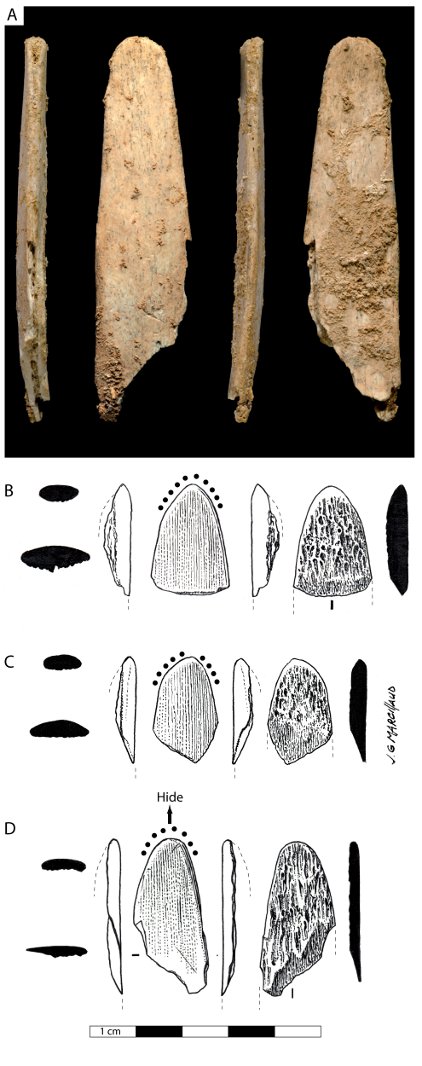Abri Peyrony - Bone Tools
In 2010, we found a bone fragment (B) with a rounded and polished tip that looked nearly identical to one (D) that Marie Soressi had found in her excavations of Pech-de-l'Azé I. These two bone fragments, both ribs, match similar fragments from the Upper Paleolithic that have been identified as lissoir (or smoother). We then took a closer look at the bags of small finds (5-25mm bones coming from the screens), and we found another similar fragment (C). Then in September of 2012, we found a third (A), much more complete, example during excavations.
All three of these bones plus the Pech-de-l'Azé I fragment are shown in the figure here. We published a complete description of the bones and their context in the Proceedings of the National Academy of Sciences (open-access). Included in this publication are interactive 3D models of the bones based on high-resolution CT scans.
One of the Abri Peyrony bones tools (B) comes from level L-3A. This level has several bifaces and is clearly Mousterian of Acheulian Tradition (MTA). The two others (A,C) come from the underlying L-3B. A more recently completed anlaysis of this assemblage shows that it is not MTA. It is characterized by discoidal technology and a high percentage of notched tools.
Radiocarbon dating of bones from L-3A and L-3B gives a calibrated age range of 42-47 ka. The two levels are statistically indistinguishable. OSL samples have been taken from these levels as well and are currently being analyzed. The level containing the Pech-de-l'Azé I bone was dated using OSL with a result of approximately 51 ka. A more complete set of OSL dates for Pech-de-l'Aze I and the OSL dates for Abri Peyrony will be presented at the up-coming ESHE meetings.
The bone tools from Abri Peyrony became the subject of a PhD study led by Naomi Martisius under the direction of Teresa Steele at the University of California at Davis. This work included a search through other collections, such as Pech de l'Azé IV, Roc de Marsal, and Jonzac for additional examples of lissoirs. The core of Martisius' work was an extensive set of replication and controlled experiments to better understand bone wear and to better interpret the use of these tools. This work has resulted in a series of publications on the subject. Martisius also worked with Frido Welker to conduct ZooMS analysis of the lissoirs using a novel, completely non-destructive method whereby the residues from the boxes that stored the lissoirs are sampled. This work, which is also published, suggests that Neandertals preferentially selected ribs from aurochs and bison for lissoir production.
